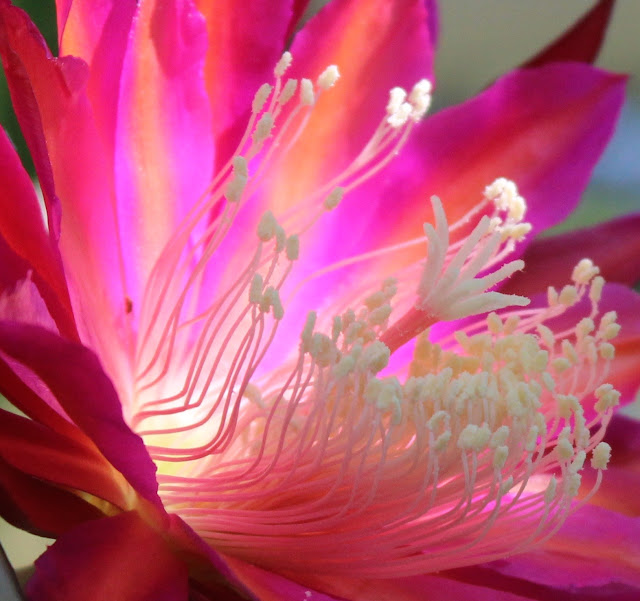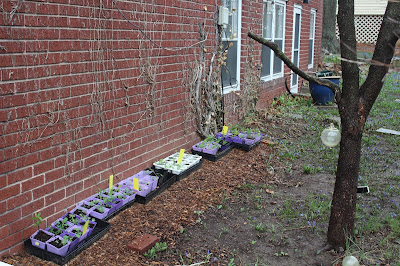The rainy days come with occasional ventures out into the garden.
When the ground is wet the weeds pull easily. That is as true in March as it is in August.
I am a prepared gardener. I have dry dirt. It is carefully put away in the garage waiting for moments like this.
Rainy days mean I can pot up bluebells and pulmonaria and many other things. This year I am potting hellebores.
October has the great plant migration inside.
March and April have the great migration from the ground into the many pots in my garage.
For the first time this year there is no frost in the forecast.
Many of this winter's seedlings have gone outside to experience the elements for the first time. The fact that it is overcast and not that hot is just about the best.
There is an explosion in the garden. Each day there are so many new things. Yesterday I saw the early hosta were emerging. Then there were the dutchman's britches. The very first primrose flower appeared. The star magnolia bloomed, the true herald of spring.
The scilla (or squill) are beginning to flow around the yard, creating the first of two wonderful blue periods for the garden.
When the sun was out on Thursday the crocuses sang loudly. It was a multicolored chorus.
I wave at someone walking by. I wish I could let them know what wonders they many be missing.
We have had a contest. There is a winner. In a landslide Unforgettable, the Orchid Cactus, has been elected.
The full voting was
Unforgettable 32
Night Blooming Cereus 13
Cactus 6
This coming week?
Well I am going to give it a rest and then be back at you with more pictures and maybe some more voting. Maybe we will have that team competition I have mentioned. Maybe we will have an all winners event.
But for now I will give you a few pictures of the garden this week. And of course there is this wonderful dessert that Julia has written about.
Bonus time
Iris reticulata
The sunshine brought out the crocuses on Thursday.
Here is a little windflower, anemone blanda.
One of the prettiest crocuses is "tricolor".
Crocuses do make a good group picture.
The hellebores are blooming. This one even almost lifts its face.
Here are the seedlings out for some conditioning. This is a south facing wall. I put them by the wall to protect them from the wind.
This lovely flower is a corydalis. I am up to 5 of these plants at this point. I am going to order more right away. This impulse is why the bulb catalogues come in the spring and the fall. They bloom at the same time as the squill and make a really wonderful combination.
Here is another corydalis. The foliage is good too.
Lemon Pudding Cake
By Julia Mears
Philip took a picture of the lemon alongside a pineapple and a red onion, which were destined to become part of pineapple salsa, but made an attractive still-life sort of grouping for a hot minute.
We started by zesting the lemon (Philip did this part). We have a microplane with a tray sort of thing below the cutting side, which catches the zest. Very handy. We ended up with 1 tablespoon of zest, exactly the right amount. Then I cut the lemon in half and juiced it. I topped up the juice to get1/3 cup lemon juice.
I am not sure why this picture is next, but it does illustrate the actual baking apparatus: 6 ramekins (each of which holds about 1 cup) in a baking pan with a rim.
Next I separated two eggs, putting the yolks in a larger bowl, and putting the whites in a smaller bowl. I added a pinch of salt and 1/4 teaspoon of cream of tartar to the egg whites and beat them with an electric hand mixer until they had stiff peaks, as pictured below. Once the egg whites were whipped, I set that bowl aside and turned my attention to the larger bowl. I added the lemon juice and lemon zest to the bowl with the egg yolks and beat that up with the mixer. The residual egg whites on the beaters were not (and are not) a problem.
Then I added I cup regular white sugar, 1/4 cup of white flour and 2/3 cup of milk to the egg yolk mixture. Along with another small pinch of salt. Then I mixed all that up with the mixer.
At that point, I had two bowls of stuff - one bowl of stiffly beaten egg whites and one bowl of everything else. I turned on the oven and set it for 350 degrees.
Next I scraped the egg whites into the bowl of egg yolks etc. with a rubber spatula and folded. That is, I used the rubber spatula to mix the whites gently into the yolks. Down to the bottom of the bowl with the spatula, then up and over, repeat. For some reason this is called folding.
When the egg whites were mostly mixed in, as to the right, I was ready to portion the mixture.
I used a ladle (with about a 1/2 cup capacity), and I ladled one ladle-ful into each ramekin. Do not lube up the ramekins! You will get 6 and have a bit left over to distribute among the ramekins in a fair and even-handed way.
After the ramekins were filled, I added one quart of hot tap water to the pan so that the ramekins sat in water about part way up the sides.
I carefully carried the pan with ramekins over to the oven and slid it in. In my oven the puddings baked for about 40 minutes. I suggest checking after 30 minutes. You are looking for the slightly browned and slightly cracked tops as to the right.
I have made this recipe with King Arthur Gluten-free flour instead of all purpose flour, and it worked just fine. I have baked the whole recipe in a single bigger round souffle dish. It takes a bit longer (like 55-60 minutes) to bake. If you like lemon desserts, you will like this. It is good warm (not straight from the oven, which would be too hot) or cold.
The end.
Reflections will come later.
Philip



















2 comments:
Re: the seedlings. Could you explain "conditioning?"
That means getting them used to the "conditions" of being outside in the sun and wind and rain. I plant that has been indoors all winter for example will get sunburned like a person unless introduced to the hot sun gradually.
Post a Comment